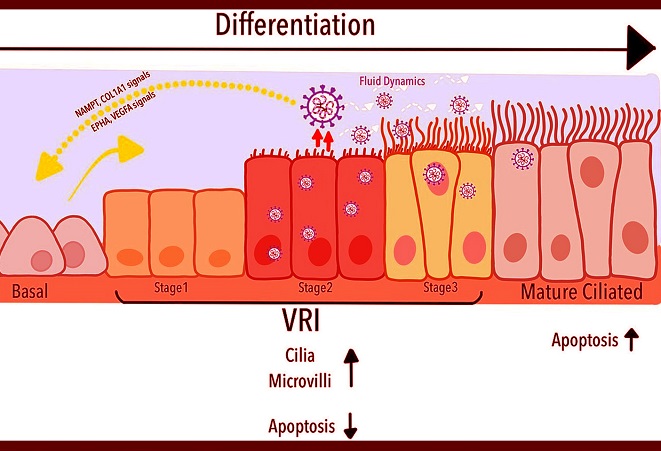Nikhil Prasad Fact checked by:Thailand Medical News Team Dec 17, 2024 11 months, 10 hours, 18 minutes ago
Medical News: Researchers from Dongguk University in Seoul, Republic of Korea, have made groundbreaking discoveries about SARS-CoV-2, the virus responsible for COVID-19. Through an in-depth study, they have identified a new class of cells, termed virus-rich intermediate (VRI) cells, as central players in the virus’s infection dynamics within the human airway epithelium. The study covered in this
Medical News report, provides vital insights into how SARS-CoV-2 interacts with host cells, potentially paving the way for innovative therapeutic approaches.
 Discovery of Virus-Rich Cells in SARS-CoV-2 Infection
Understanding the Airway and SARS-CoV-2’s Infection Mechanism
Discovery of Virus-Rich Cells in SARS-CoV-2 Infection
Understanding the Airway and SARS-CoV-2’s Infection Mechanism
The human airway epithelium is a complex tissue composed of various cell types that protect against infections and maintain respiratory health. SARS-CoV-2 infects these cells by binding to ACE2 receptors, enabling viral entry. Previous studies primarily focused on fully differentiated cells, particularly ciliated cells, as the primary targets. However, this study explores the role of less-characterized transitional cells in the infection process.
VRI cells, identified as intermediates in the differentiation pathway from basal to ciliated cells, were found to harbor high viral loads across various stages of infection. These cells exhibit unique characteristics that make them highly susceptible to infection while simultaneously playing an essential role in viral propagation. The study used advanced air-liquid interface cultures and single-cell RNA sequencing datasets to uncover these critical findings.
What Makes VRI Cells Special?
The researchers categorized VRI cells into three subtypes: VRI_stage1, VRI_stage2, and VRI_stage3. Each subtype represents a different stage of differentiation and response to infection:
-VRI_stage1: These early-stage cells show high expression of basal and secretory cell markers. They are metabolically active and represent the initial targets for viral entry due to their elevated ACE2 receptor levels.
-VRI_stage2: This stage comprises newly infected cells. VRI_stage2 cells exhibit significant viral replication, strong interferon responses, and robust inflammatory gene activation. Despite these responses, these cells show suppressed apoptosis, allowing the virus to replicate unchecked.
-VRI_stage3: These pre-ciliated cells are less involved in antiviral defense but play a critical role in facilitating viral release and spread.
Interestingly, VRI_stage2 cells showed the highest viral load, surpassing even ciliated cells, which were previously considered the primary replication sites. The virus appears to exploit the transitional state of these cells, leveraging their high metabolic activity and reduced cell death rates to enhance its lifecycle.
How SARS-CoV-2 Hijacks VRI Cells
The researchers found that SARS-CoV-2 induces changes
in VRI cells to optimize viral replication and spread. VRI cells upregulate genes associated with microvilli and cilia formation, such as EZR and VIL1, which enhance viral entry and release.
Moreover, the virus modulates host immune responses within these cells. For example, infected VRI_stage2 cells show elevated interferon responses but display suppressed activation of certain antiviral genes, suggesting an intricate immune evasion strategy.
Additionally, VRI cells send signals to basal cells via pathways like EPHA and VEGFA. These signals activate the MAPK pathway, promoting basal cell differentiation and proliferation. This interaction contributes to the expansion of the VRI cell population, creating a continuous supply of susceptible cells for viral infection.
Implications for Disease Progression and Severity
The discovery of VRI cells sheds light on why some individuals experience prolonged or severe COVID-19 symptoms. The persistent viral replication in VRI cells may lead to sustained viral shedding and chronic inflammation. Furthermore, these cells contribute to the impaired mucociliary clearance observed in severe cases, as the virus disrupts the normal function of the airway epithelium.
Therapeutic Potential and Future Research
Targeting VRI cells presents a promising avenue for therapeutic intervention. By disrupting the pathways that promote VRI cell differentiation or their interactions with the virus, it may be possible to reduce viral load and mitigate disease severity. Potential strategies include:
-Developing drugs that inhibit the MAPK pathway to limit the expansion of VRI cells.
-Targeting specific genes upregulated in VRI cells, such as EZR and VIL1, to disrupt viral entry and release.
-Modulating immune responses within VRI cells to enhance antiviral defense without promoting inflammation.
Further research is needed to validate these findings in vivo and to explore the long-term effects of SARS-CoV-2 infection on VRI cells. Understanding the molecular mechanisms underlying VRI cell differentiation and their unique susceptibility to infection will be crucial in developing targeted therapies.
Conclusion
This study underscores the critical role of VRI cells in SARS-CoV-2 infection dynamics. By exploiting these transitional cells, the virus enhances its replication and evades host defenses, contributing to disease progression. Targeting VRI cells and their associated pathways could offer novel strategies for combating COVID-19. As our understanding of these cells deepens, so does the potential for groundbreaking treatments to mitigate the global impact of this pandemic.
The study findings were published in the peer-reviewed journal: Frontiers in Microbiology.
https://www.frontiersin.org/journals/microbiology/articles/10.3389/fmicb.2024.1507852/full
For the latest COVID-19 News, keep on logging to Thailand
Medical News.
Read Also:
https://www.thailandmedical.news/news/aryl-hydrocarbon-receptor-identified-as-a-proviral-host-factor-for-sars-cov-2-replication-and-can-used-as-a-therapeutic-target-against-all-variants
https://www.thailandmedical.news/news/sars-cov-2-causes-cathepsin-l-upregulation-which-in-turn-raises-risk-of-cancer-and-tumor-progression
https://www.thailandmedical.news/news/the-role-of-g3bp-in-sars-cov-2-replication
https://www.thailandmedical.news/articles/coronavirus
